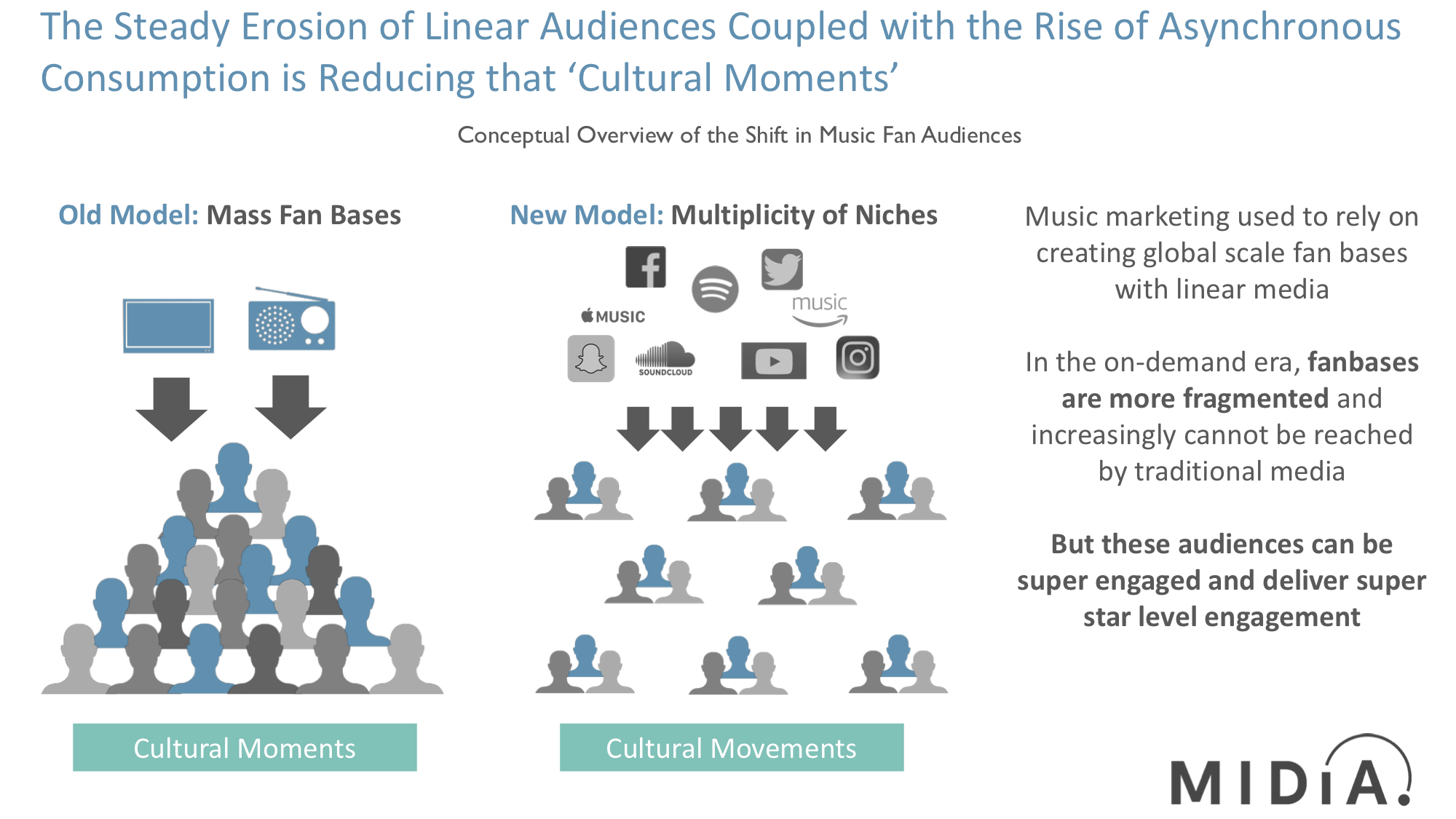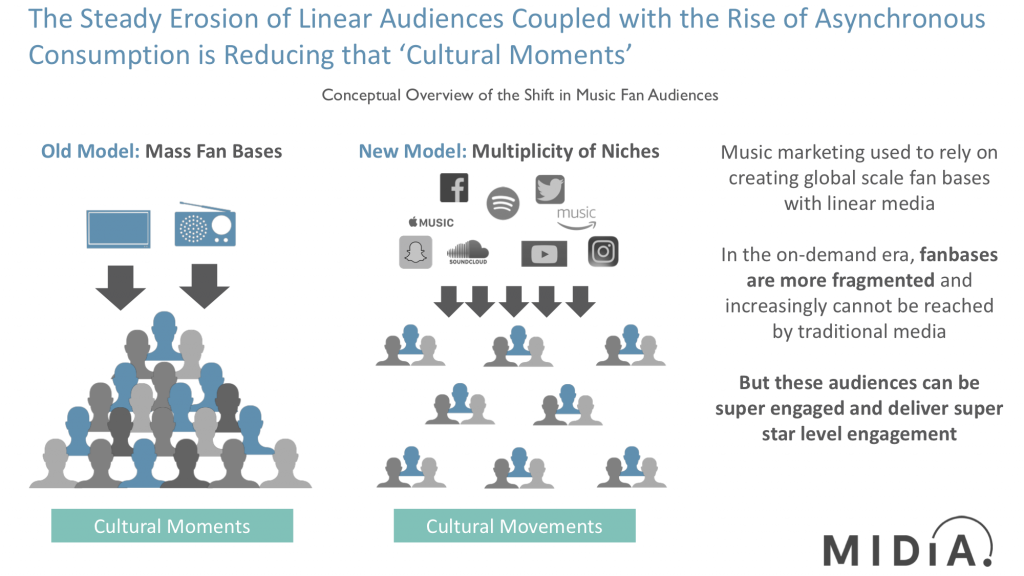Niche is the New Mainstream


Fandom is fragmenting. Streaming personalization and falling radio audiences are combining to rewrite the music marketing rulebook, ushering in a whole new marketing paradigm. Hits used to be cultural moments; artist brands built by traditional mass media. However, this fire-hydrant approach to marketing lacked both accountability and effective targeting. Now, hyper targeting, both in marketing campaigns and streaming recommendations, is creating a new type of hit and a new type of artist. Global fanbases are being built via the accumulation of local niches, while a few big hits for everyone are being replaced by many, smaller hits for individuals. Niche is the new mainstream.
The marketing rulebook is being re-written
Three trends have reshaped how music marketing works:
- Digital targeting: The rise of social media provided label marketing teams with masses of data and unparalleled targeting
- Linear decline:The steady decline of linear radio and TV audiences is eroding these platforms’ contribution to music marketing effectiveness
- Streaming curation:Streaming algorithms and curation teams are overriding label marketing efforts, delivering users what the streaming services want to deliver rather than what labels want to

Artist marketing used to be about building exposure and brands across mass market analogue platforms. With radio, TV and print all in decline – especially among the crucial younger audience segments – that approach is being replaced with targeted digital campaigns which in turn are fragmenting fandom and transforming what global fanbases look like:
- The marketing transition:Marketing of media brands is locked in a transition phase, moving from the old model of one-to-many messaging to targeted digital campaigns. As in all transitions, the old and new models will co-exist for some time. For music marketers though, there is a greater need for emphasis on digital because this is where the younger music fans are that are so crucial to the success of so many frontline acts.
- Democratization of access:In the old model, mainstream linear media (TV and radio especially) was the power tool of big record labels. Access to these finite schedules is inherently scarce and bigger record labels have an inbuilt advantage due to their scale and influence. In on-demand environments access is democratized, with anyone able to run their own self-serve campaigns on platforms such as Facebook, Snapchat, YouTube and Google search. The result is that labels and artists of all sizes can reach their global audiences.
- From cultural moments to cultural movements:Linear schedules have the unrivalled ability to create simultaneous audiences at scale around a specific piece of content. Creating these cultural moments remains the crucial asset that TV and radio bring. But the weakness of this approach is that much of the impact is diluted. It is carpet bombing compared to the laser-guided missile of digital marketing, resulting in a lot of wasted exposure and effort. Mass reach is progressively less useful for driving fandom. Against this, the hyper-targeting of digital creates super-engaged fanbases that can often thrive under the mainstream radar. Kobalt artists such as Lauv (2.5+ billion streams) and Rex Orange County (0.8+ billion streams) are examples of this new paradigm, creating global-scale cultural movements rather than linear cultural moments. Niches thrive in this world of fragmented fandom, but niche no longer inherently means small. Indeed, the cumulative effect of many local niches is global-scale fanbases. Niche is the new mainstream.
The old living side by side with the new
As when every new paradigm shift occurs, the old and the new will live side by side. There will still be plenty of artists that appeal to younger audiences that become household names too across mainstream media – look no further than Billie Eilish. But make no mistake, the shift is happening. More and more global artist success stories will happen outside the mainstream. These fan bases will be increasingly passionate and loyal, acting as strong platforms for building impactful artist stories. Success will be built around audiences that want a piece of everything that artist has to offer, from streaming to merch to tickets. This is how independent artists and many independent label artists have been building careers for years. They no longer have the exclusive, however.
Fragmented fandom is an asset, not a challenge
Artists that once would have been household names – mass media brands with large but often passive fanbases – are now rising as under-the-radar superstars. It has never been more important for this to happen. With streaming pushing more listeners towards tracks and away from artists and albums, building passionate clusters of fans is not just key to success, it is the very thing that success will be built on. Fandom is fragmenting but it may be the best thing that has ever happened to it.
This blog post pulls insight from a forthcoming MIDiA report Music Marketing: Niche is the New Mainstream that will be published in MIDiA’s new Marketing and Brands service. To find out more about how to get access to this research practice – a must have for anyone involved in marketing of media brands – email stephen@midiaresearch.com

There is a comment on this post, add your opinion.